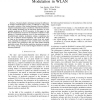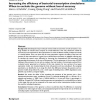253 search results - page 5 / 51 » When More Alternatives Lead to Less Choice |
EOR
2006
13 years 7 months ago
2006
When two competing and incompatible products coexist in a market, potential users face a choice between the two products and the alternative of deferring the decision. This paper ...
RTSS
1997
IEEE
13 years 11 months ago
1997
IEEE
In [6], we proposed a new commit protocol, OPT, specially designed for use in distributed firm-deadline real-time database systems. OPT allows transactions to “optimistically�...
VTC
2007
IEEE
14 years 1 months ago
2007
IEEE
— Channel-adaptive techniques increase the efficiency of wireless communications, as they are efficient in coping with the quality variation of the wireless channels. However, ...
TMM
2011
13 years 2 months ago
2011
Past research on automatic laughter classification / detection has focused mainly on audio-based approaches. Here we present an audiovisual approach to distinguishing laughter fr...
BMCBI
2008
13 years 7 months ago
2008
Background: Simulating the major molecular events inside an Escherichia coli cell can lead to a very large number of reactions that compose its overall behaviour. Not only should ...


